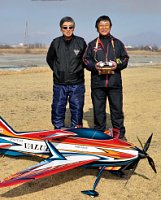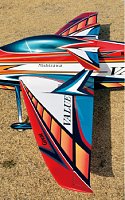made an aircraft that can look bigger in the 2m standard of F3A rules. It is a monoplane that is easy to handle, and we are aiming for a fuselage that has a large side lift comparable to that of a biplane.
When I made the pillars (side stays) that support the upper and lower wings thinner on the biplane, I found that there was a considerable difference in the floating of the knife edge. Therefore, we tested how effective a monoplane would be when a side stay like a biplane was attached. I tried installing it on the leading edge of the wing, in front of the canopy, under the nose, etc., but the directionality tends to be worse in front of the center of gravity, and when installed in front of the canopy, the aircraft swings left and right at low speed , I had a hard time landing.
Also, maintaining lift with the fuselage alone requires a fair amount of volume, and as a result, straight-line stability tends to be sacrificed unless the tail volume is also increased.
In order to develop "VALUE", we first changed the way of thinking, changed the mounting position of each part of the aircraft, changed the size, and as a result, we found that sufficient lift can be obtained even from the center of gravity to the rear part.
"Value" keeps its style, and without lowering the tail in the knife edge state, Square Eight etc. works as controlled by the ladder. The rudder responds better because the sides do not sink. As a result, the aircraft is easy to fly even at the front center of gravity. The responsiveness of the rudder leads to improved stallability, and the spin also rotates at a constant speed.
There is also a tail volume effect, and there is enough area to prevent the tail volume from becoming insufficient even when using contra (contra-rotating).

I made an aircraft that can look bigger in the 2m standard of F3A rules. It is a monoplane that is easy to handle, and we are aiming for a fuselage that has a large side lift comparable to that of a biplane.
When I made the pillars (side stays) that support the upper and lower wings thinner on the biplane, I found that there was a considerable difference in the floating of the knife edge. Therefore, we tested how effective a monoplane would be when a side stay like a biplane was attached. I tried installing it on the leading edge of the wing, in front of the canopy, under the nose, etc., but the directionality tends to be worse in front of the center of gravity, and when installed in front of the canopy, the aircraft swings left and right at low speed , I had a hard time landing.
Also, maintaining lift with the fuselage alone requires a fair amount of volume, and as a result, straight-line stability tends to be sacrificed unless the tail volume is also increased.
In order to develop "VALUE", we first changed the way of thinking, changed the mounting position of each part of the aircraft, changed the size, and as a result, we found that sufficient lift can be obtained even from the center of gravity to the rear part.
"Value" keeps its style, and without lowering the tail in the knife edge state, Square Eight etc. works as controlled by the ladder. The rudder responds better because the sides do not sink. As a result, the aircraft is easy to fly even at the front center of gravity. The responsiveness of the rudder leads to improved stallability, and the spin also rotates at a constant speed.
There is also a tail volume effect, and there is enough area to prevent the tail volume from becoming insufficient even when using contra (contra-rotating).
⬆ Kiyoshi Nishizawa (right, Nagano Flying Friend member) who skipped the final prototype before mass production, and Hajime Nishioka (Yamanashi) of Nishioka Seisakusho, the designer and manufacturer of this machine.
The aircraft is equipped with a German-made Amberdan AVR contra drive unit, propeller: Brenner 22 x 20 (front) / 22 x 22 (rear), Power Magic 5200mAh, Futaba 18MZ.
The characteristic of Contra is that the large propeller of 22 to 23 inches double-brake, which makes the direction worse.
Adding tail fins will improve the direction, but it cannot be suppressed when the wind is strong. Therefore, we have prepared an optional fin that is large enough to cover even strong winds.
It is a twin fin that is attached to the left and right elevators so that it can be attached to the rear position as much as possible. When installing the fins, you can apply resistance to your liking, and if you set it so that it looks like a "H" when viewed from above, the resilience of the aircraft will improve. You can also tape the fins to check the desired mounting angle before fixing.
This time, in addition to the pre-painted finished machine, we also prepared a finished machine that is still painted white. Just like the pre-painted finished machine, the linkage parts are included, just without the color paint, so you can fly it in white.

⬆ The aircraft "looks big" It features a fuselage volume not found in conventional aircraft. The amount of ladder at the time of knife edge is also minimal.
"VALUE" is also a big feature that you can attach and detach canard wings and side stays with one touch without using tools.
To that end, we have made many expensive custom parts.
You can also fly with the side stays removed. Since the aircraft with a high lateral effect has a good rudder response, it is also effective for practice to fly with it removed until you get used to the rudder operation.

On the other hand, if the canard wing is removed, it will cause a slight nap when operating the rudder at the knife edge, so it will not cause "sleeping" if it is left attached.
Even if the side stays are removed, there is no peculiarity, but it is better to attach them for straightness and it is effective when rolling.
The appeal of "VALUE" is its high-quality painting and time-consuming design. Composites have evolved further and are now beyond the balsa machine.
It does not absorb water even on rainy days. Design is important for molding the machine, but we sent the wooden mold we made to the factory and made the mold with a 3D printer.
Innovative design creates value. As long as the 2m rule does not change, it is an aircraft that can be flown for many years over a long period of time.
⬅ The main tail is a "leading edge oval type" with an arc on the leading edge. Snap roll special inquiry: Nishioka Seisakusho The shape is designed with an eye on its characteristics.
[Technical data]
●
Overall length of the fuselage : 1992 mm
(at the time of 90 mm long spinner)
Overall height: 518 mm (Vertical tail wing height: 498 mm)
● Main wing (leading edge oval type)
Overall width: 1970 mm
Surface area: 66.52d ㎡ Wing
chord length: 518 mm ⇒ 150 mm
Wing thickness: 45 mm ⇒ 20 mm
● Horizontal tail wing (leading edge oval type)
Overall width: 850 mm
Surface area: 18.2
d㎡
Wing chord length: 310 mm ⇒ 128 mm Wing thickness: 27 mm ⇒ 17 mm
● Canard wing
total width: 640 mm
Surface area: 8.9 d㎡ Wing
chord length: 225 mm ⇒ 83 mm
● Side thrust
single propeller: Side 2.5 °
down 2.5 °
Contra propeller: Side 0 °
down 2.5 °
● Total weight of test machine (with side stay)
★ OS reduction unit
power magic 5200mAh: 4850g
Freemax 5500mAh: 4950g
★ Amberdan AVR contra unit
power magic 5200mAh: 4840g
Freemax 5500mAh: 4940g